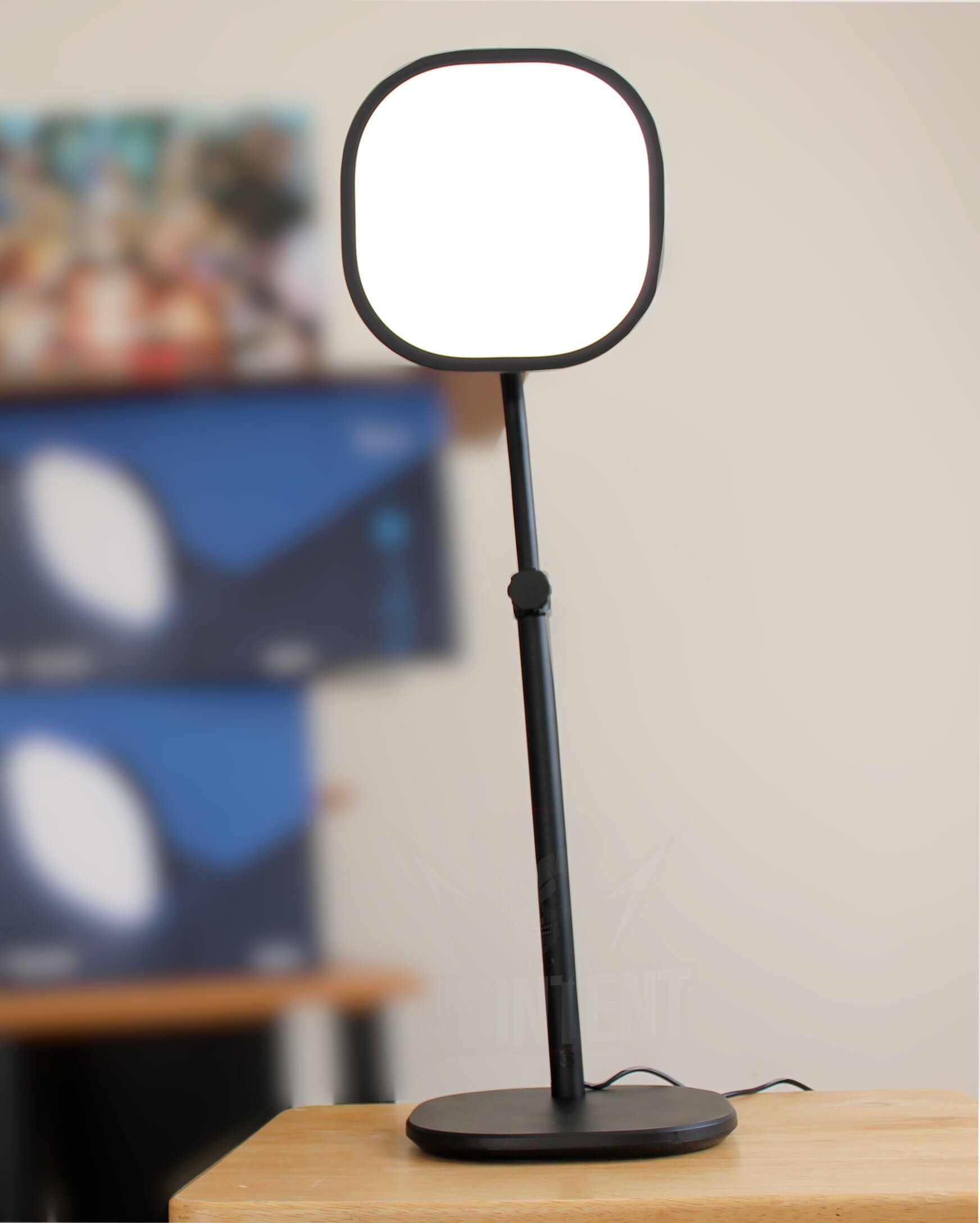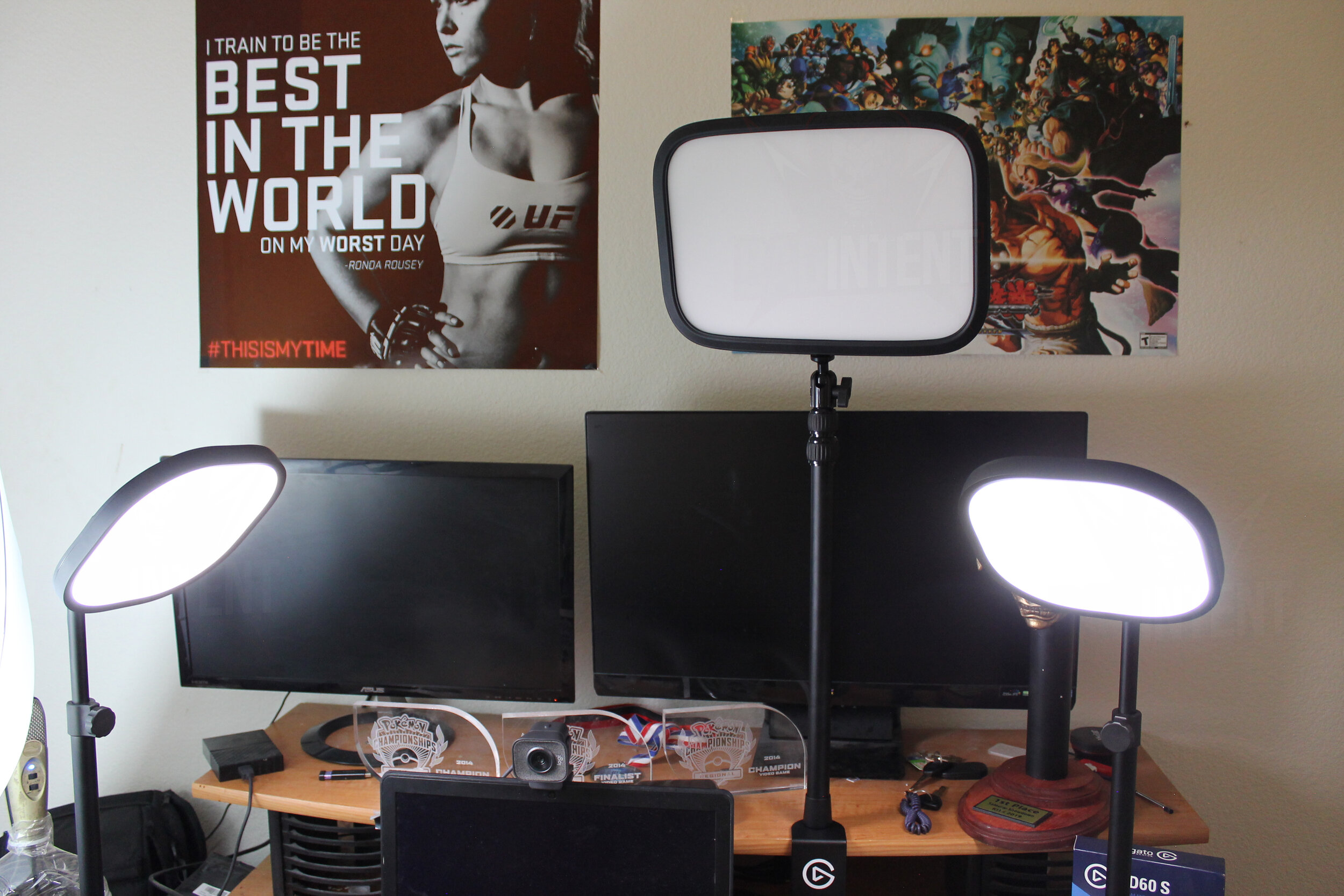Elgato Key Light vs Elgato Key Light Air [Review and Comparison]
As an Amazon Associate I earn from qualifying purchases. Amazon links in article are affiliate links.
This review focuses on the Key Light vs the Key Light Air. My updated review and comparison also includes the newer Elgato Ring Light.
Specifications
Price
Performance
Convenience and features
Verdict and differences summary
Specifications
Elgato Key Light (left). Key Light Air (right).
Elgato Key Light Air.
Elgato Key Light
Maximum brightness: 2800 lumens.
Color temperature 2900 - 7000 Kelvin.
Stand height: 22 - 49 inches.
1/4th inch thread at top and bottom of panel.
Elgato Key Light Air
Maximum brightness: 1400 lumens.
Color temperature 2900-7000 Kelvin.
Stand height 23.62 - 34.65 inches (60-88cm).
1/4th inch thread on back of panel.
Both the Elgato Key Light and Elgato Key Light Air have adjustable brightness and color temperature, but neither have physical controls for this. They must be controlled using the Elgato Control Center desktop or phone app via wifi.
Price
I bought my Elgato Key Light for $199 and my Elgato Key Light Airs for $129 each (Amazon). Since I got two Key Light Airs, I’ll be demonstrating shots with one and two Key Light Airs to show the difference.
Performance
In this section I'll go over brightness, diffusion, color temperature range, chroma key performance, and how evenly both light a shot.
Brightness
The Elgato Key Light can output up to 2800 Lumens and the Elgato Key Light Air outputs half of that at 1400 lumens. Does this mean the Key Light is really twice as bright as the Key Light Air? Not exactly.
The effective lumens - or how bright the light actually looks - is expensive to test and it's always going to be a smaller number than the raw lumens so most companies just don't share it. The best way to see how bright a light is, is to see it for yourself. So here's some side by side footage. All shots have the gain and exposure locked with the light directly in front of me.
Logitech Brio, no lighting
As the pictures show, both lights completely transform a shot previously only lit by daylight. They original Key Light is definitely brighter, but in the day time the difference isn’t drastic. It’s much more apparent when it’s pitch black. I show that in some later shots. The brightness on both can be changed using Elgato Control Center which I'll be covering in the next section.
Diffusion
Key Light panel.
Key Light Air panel.
These lights don’t come with a giant umbrella or a detachable diffusion plate. That design causes many lights to become too dim to use alone at night. With the Key Light and Key Light Air, the diffusion is built into the panel’s design. The Elgato Key Light has 160 and the Key Light Air has 80 small LEDs that illuminate from the edge inwards before being bounced off the reflective panel inside.
The result is lights that are both excellent at night while still being soft. The Key Light and Key Light Air are more than bright enough to stream and record YouTube videos with.
That said, after using these since they launched, I wouldn’t actually recommend using them head-on over long periods. They just cause too much eye strain unless you use them at an angle.
Color Temperature Range
Both the Elgato Key Light and Key Light Air are adjustable from 2900-7000 Kelvin. I couldn’t appreciate how useful this was on launch, until I tested a wide variety of ring lights with a much more narrow range of temperature. You can match daylight with both lights from morning, noon, to sunset.
Two Key Light Airs at 7000K.
Two Key Light Airs at 5150K.
Key Light 30 degree angle to the side at 2900K.
Chroma Key performance
Green screen performance is near flawless with both lights. I use the Elgato Green Screen MT (my review) as my green screen. Elgato states on their website that the Key Light performs better for chroma keying, but in my experience that’s mainly true if you’re using the lights at an angle. You need to evenly light your green screen otherwise, it becomes difficult to chroma key properly. Let’s talk about angles actually…
Even lighting
All is well with both lights so far, but now we’re going to get into the main factor to consider when buying either of these lights: even lighting. Almost all of the marketing material involving these lights has two lights, not one. I'm talking about on the website, on the box, at tech shows, even when advertising their green screen, Elgato always shows the Key Light and Key Light Air with another one nearby. This is not a coincidence.
I find there to be two main benefits to using multiple lights:
The lights can be placed at an angle reducing eye strain.
The lights can fill in remaining shadows on your face or brighten more of your background.
The following stills are from the Logitech Brio webcam with exposure set to -5 and gain at 0. White balance is locked at 4290 in OBS. Color temperature on the lights is set to about 5400 K.
Elgato Key Light directly in front at night.
Elgato Key Light at a 30 degree angle at night.
Elgato Key Light Air directly in front at night.
Elgato Key Light Air at a 30 degree angle at night.
Two Elgato Key Light Airs at night.
When there’s no other lighting at all, the Elgato Key Light starts to show its lumens superiority over the Key Light Air. Still, using two Key Light Airs is easier to look at and clears up shadows missed by just using one light.
Convenience and features
Assembly
The Key Light and Key Light Air take up little desk space.
The Elgato Key Light and Key Light Air are very easy to assemble, and they don’t take up a lot of space. The Key Light uses a clamp at the bottom which can attach to the side of your desk. The Key Light Air has a weighted base at the bottom so it's more like a lamp.
They both have a ball head to point the light exactly where you want. If you're streaming from your home, I find the Key Light Air more flexible and convenient overall. You can move them around easier and put them in more spots. The desk clamp on the Key Light means it only attaches to desks with a flat lip and it can’t be set down anywhere else.
Key Light Air with ball head screwed in.
Key Light tripod thread on bottom.
Screw on ball head for Key Light.
When you start to look at options outside the box, however, the Key Light starts to gain an advantage. It has a 1/4th inch thread on the top and bottom which lets it be screwed onto a tripod or any other mount with a standard screw. The Key Light Air also has a thread but it’s on the back plate where the ball head it comes with screws in. That makes it awkward to properly to angle if you use it on a tripod.
Both lights also connect to Elgato’s Multi Mount system (Elgato’s website). I’m pretty sure this is why they don’t talk much about the threads - they want you buying that!
Size
The Elgato Key Light gets quite tall. I’m 5’8” and the Elgato Key Light was just a few inches shorter than me. However, you can't put the Key Light on the floor without buying a separate base.
The Key Light Air can be placed on the floor, but considering its height, it’s only really useful as a backlight on the floor. So sadly, I didn't find much opportunity to utilize the full height of either of these lights.
In addition, both lights power cables aren't very long - the Key Light’s is 102 inches, and the Key Light Air’s is 78 inches. Both plugs are also bulky and block off other outlets. So that's a negative on both. These don't seem exactly fun to travel with but the metal is quite sturdy and it's pretty easy to take them apart and put back together. Just don't lose anything.
Controls
There are no knobs to control the brightness or the color temperature, so you'll have to install an app called Elgato Control Center. It was pretty annoying to set up the first (and second and third) time. Whenever you move shooting locations and/or change your internet it’s a pain to reset both lights and resync them.
I hope they patch the software to make setup smoother, because the app is honestly really good. Elgato Control Center eventually detects any Elgato Light that's on in the area. Once you do finally get it working, the Elgato Control Center app is super convenient and easy to use. Let's get into the features the app does for lights.
No knobs. Feelsbadman.
Features
This is my favorite part about both of these lights. The brightness can be increased or decreased, and the color temperature can be adjusted on both the Key Light and Key Light Air from 2900-7000 K. That's important for matching the current temperature of the sunlight coming in. Or if you have a ceiling light or lamp, you can match the temperature of that as well.
You can sync all your lights together to change the brightness and temperature of them all at the same time. You can even turn them all off or on at the same time without having to reach over and fish for the power switch on all of them whenever it's time to stream or record. I thought I was gonna hate this app, but so far I love it (when it works). You can also control the brightness with the Elgato Stream Deck, and it’s great to see that type of support from the manufacturer.
Verdict and differences summary
The major differences between the Elgato Key Light and Elgato Key Light Air are:
the Key Light is bigger and brighter (2800 lumens vs 1400).
the Key Light is more expensive ($199 vs $129 at the time of the Key Light Air’s launch).
The Key Light Air has a flat base compared to the Key Light’s desk clamp.
Ultimately, the choice is still simple. I recommend getting two Elgato Key Light Airs. You need two lights so you can be evenly lit. Even if you want one brighter than the other for a cinematic effect, one light source just won't fill on your whole shot.
At the time of my purchase, buying two Key Lights was $400. That’s OD. Alternatively, $260 (prices fluctuate) gets you two Key Light Airs which give you a very bright and even shot.
Elgato Key Light https://amzn.to/3bcM3YK
Elgato Key Light Air https://amzn.to/2VW9zEX







